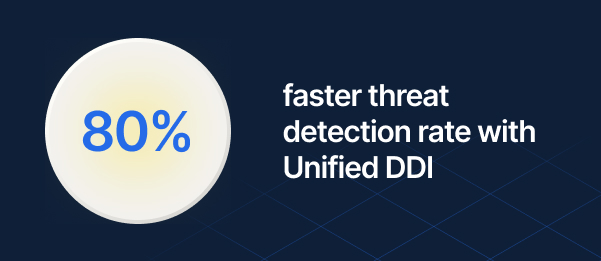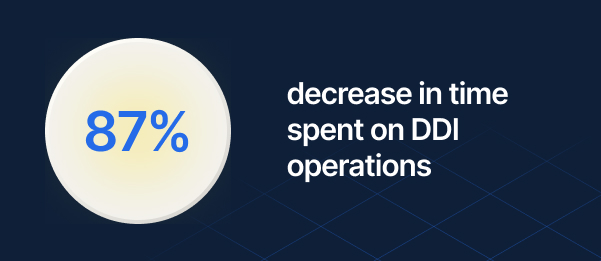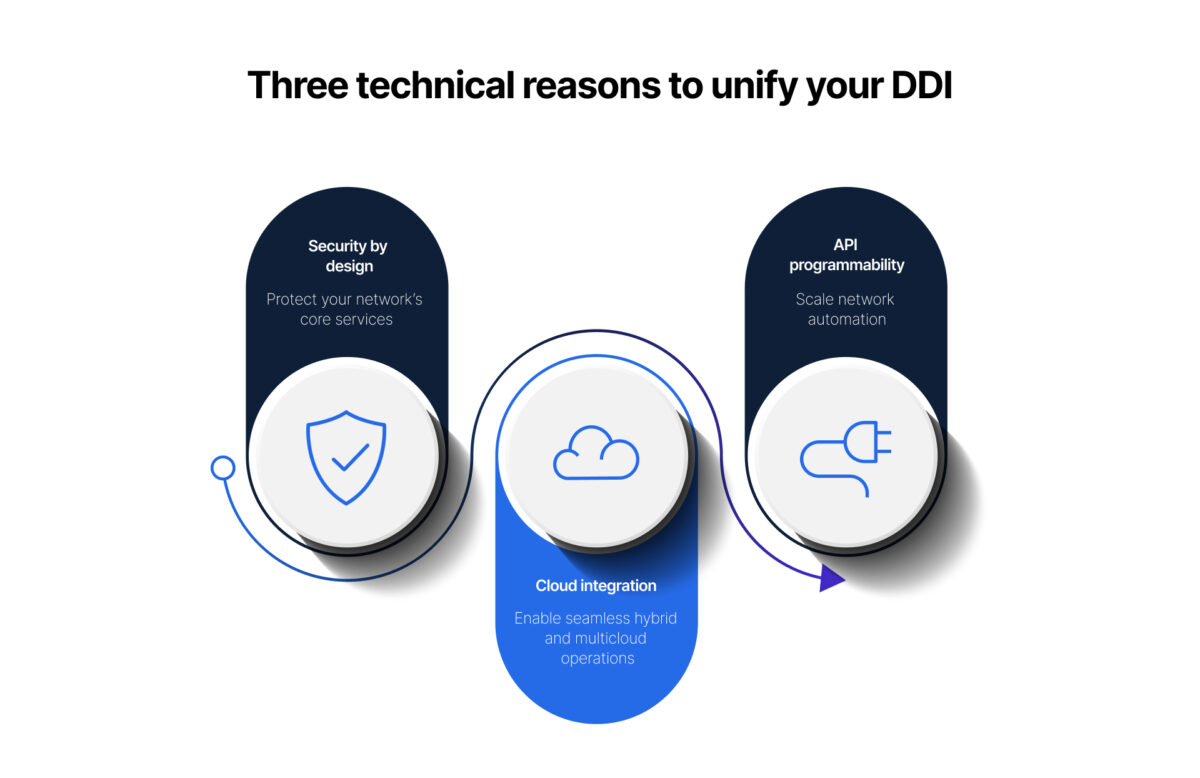Three technical reasons to let go of legacy tools and unify your DDI
Learn with BlueCat how security by design, cloud integration, and API programmability offer three technical reasons to adopt Unified DDI.

This is the final of three blog posts exploring nine key reasons to move managing your DNS, DHCP, and IP address management (together known as DDI) from a legacy approach to a unified management solution. The posts in this series are drawn from our white paper, Nine reasons to unify your DDI: Strategic advantages for modernizing your DNS, DHCP, and IP address management.
Technical capabilities play a critical role in supporting innovation, scalability, and security in enterprise IT environments, with DDI forming the backbone of any network.
However, legacy DDI management tools often fall short of meeting modern enterprise network requirements. These limited capabilities can lead to security gaps, create bottlenecks for cloud adoption initiatives, and impede network automation efforts.
It’s tempting for enterprises to get by with the status quo. Why invest in new technology when what you have works well enough? But as the technical debt of legacy tools accrues, the risks to your organization continue to grow.
Moving to a unified DDI platform delivers the technical enhancements necessary for organizations to stay ahead of modern network demands. Here are three compelling technical reasons why unifying your DDI is essential for building a future-proof network:
- Security by design
- Cloud integration
- API programmability
In this post, we’ll explore how each of these technical reasons helps optimize your core network infrastructure. Furthermore, we’ll highlight BlueCat’s solutions for unifying your DDI.

Security by design: Protect your network’s core services
Legacy DDI systems are often riddled with vulnerabilities: fragmented security controls, limited visibility, and reliance on manual processes that create gaps attackers can exploit. With DNS increasingly targeted for attacks, organizations can’t afford to leave their core network services exposed.
Unified DDI transforms security by implementing a comprehensive, built-in approach. Features like centralized policy enforcement, real-time threat detection, and automated response capabilities ensure that your network remains secure against evolving threats. According to Enterprise Management Associates (EMA), enterprises that adopt unified DDI report an 80% faster threat detection rate and significant improvements in incident response times.

BlueCat’s unified DDI supports advanced DNS security features like DNSSEC to protect against cache poisoning and spoofing attacks. It also offers tools to protect against other common DNS attacks. Furthermore, BlueCat Threat Protection enhances security by dynamically updating blocklists to defend your network from emerging threats.
Additionally, unified DDI supports zero-trust security models through granular access controls and consistent policy enforcement. Role-based access management, based on principles of least privilege, ensures that only authorized users can make changes to your DDI environment. Meanwhile, detailed audit logging tracks every action for analysis and action. This reduces the attack surface and ensures compliance with regulatory standards. By adopting unified DDI, organizations gain the confidence that their network’s foundation is secure, resilient, and ready to withstand modern cyber threats.
Cloud integration: Enable seamless hybrid and multicloud operations
The shift to hybrid and multicloud environments has introduced complexity that legacy DDI systems simply can’t handle. Managing DNS across multiple clouds, maintaining visibility, and ensuring consistent configurations are enormous challenges for IT teams.
Unified DDI simplifies these complexities through integration and automation capabilities built for hybrid and multicloud environments. Automated discovery continuously tracks new cloud resources and synchronizes them with your DDI environment. This provides a single source of truth across your entire cloud landscape. This real-time visibility bridges all cloud platforms. It eliminates manual tracking of DNS zones and records, as well as DHCP scopes and IP spaces.
With BlueCat’s intelligent DNS resolution, unified DDI also optimizes query performance. It dynamically routes requests to the most appropriate resource, whether on premises or in a cloud environment. For organizations managing thousands of daily DNS changes in dynamic cloud environments, this translates to seamless operations without bottlenecks and manual efforts. Advanced features such as automated conflict resolution and policy enforcement ensure consistency and reliability across multiple clouds. This simplifies cloud adoption and migration across clouds.
By adopting unified DDI, enterprises can support advanced cloud architectures with less overhead and cross-cloud visibility. Whether it’s enabling intelligent failover between cloud providers or ensuring compliance through automated policy enforcement, BlueCat unified DDI empowers organizations to accelerate cloud adoption while maintaining control and reliability.
API programmability: Scaling network automation
In the age of DevOps and infrastructure as code, automation is non-negotiable. Yet many legacy DDI systems lack the API capabilities necessary to support modern automation workflows. This leaves IT teams bogged down in manual tasks.

Unified DDI changes the game by providing robust API programmability, enabling seamless integration with existing tools and platforms. With BlueCat’s APIs, organizations can automate critical DDI functions. This includes provisioning new apps and resources, updating configuration changes, integrating with CI/CD pipelines, and enabling self-service provisioning through IT service management systems. This ensures continuous deployment and faster time-to-value for new applications.
For large-scale operations, BlueCat’s APIs support custom integrations with security tools, cloud platforms, and network orchestration systems, enabling end-to-end automation. For example, changes in cloud infrastructure can trigger automated DNS updates, ensuring synchronization without manual intervention. Additionally, adaptive plugins and applications for BlueCat Gateway streamline the development of custom workflows. This allows organizations to tailor their DDI automation to meet their specific business needs.
The results speak for themselves. Enterprises adopting unified DDI report an 86.8% reduction in time spent on DDI operations and accelerated service delivery by 90%. With APIs designed for flexibility and scalability, unified DDI makes your network change-ready. The result is sophisticated automation and integration scenarios that evolve with your business needs.

Get Integrity or Micetro for Unified DDI
Unified DDI is more than a modernization effort; it’s a technical evolution that ensures your network is change-ready to meet the today’s and tomorrow’s demands. The technical advantages of unified DDI are clear, from bolstering security and integrating with cloud environments to enabling network automation at scale.
BlueCat Micetro provides a non-disruptive path to Unified DDI. It orchestrates your existing DNS, DHCP, and IP address management infrastructure through a centralized management overlay. Organizations can benefit immediately while maintaining their current DDI investments. Meanwhile, BlueCat Integrity delivers a comprehensive, enterprise-grade DDI platform. It offers complete control over your DDI infrastructure with built-in automation, security, and cloud integration capabilities.
For enterprises looking to build a network that supports innovation, agility, and resilience, unifying your DDI isn’t just an option—it’s a necessity. And an approach that can transform your technical foundation.
Contact us today to learn how Integrity or Micetro can help unify your DDI.
Did you miss the first two blog posts in the series? Read up on the three business-focused reasons and the three operational reasons to optimize your network with Unified DDI.




